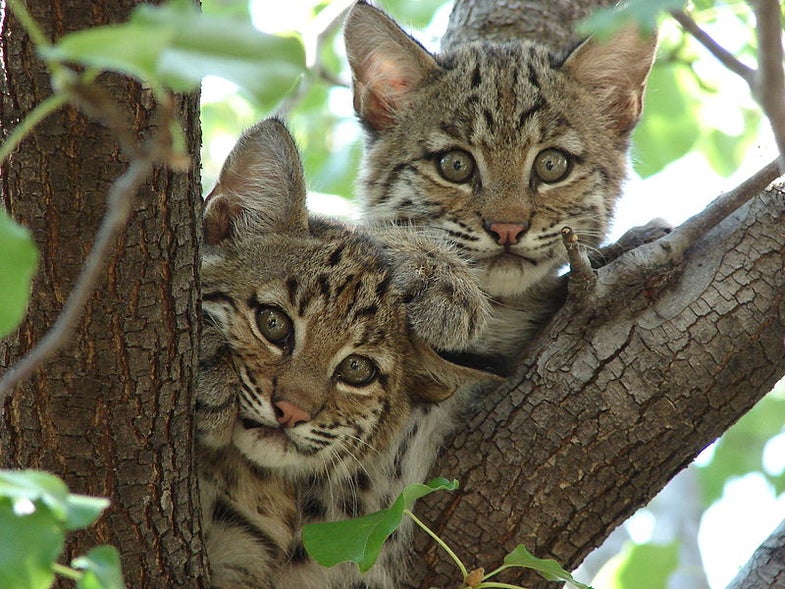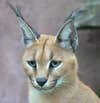Click to launch the gallery.
Caracal
Apple’s previous versions of OS X have been named after the biggest, best-known wild cats in the world–all four members of the “big cat” subfamily Panthera (lion, tiger, leopard jaguar) plus slightly smaller but still famous cats (cheetah, snow leopard) and, annoyingly, three separate instances of P. concolor (mountain lion, puma, and panther, which are three names for the same animal). But what about, say, the caracal? The caracal (its Linnaean name is, I swear, Caracal caracal) is a smallish wild cat, about the size of a lynx, that lives throughout Africa and the Middle East. It’s best known for its long black ear-tufts–many cats, including some domestic breeds like the Norwegian forest cat, have tufts, but the caracal’s are exceedingly long (and, I’d argue, elegant). It is also an absurdly high leaper, even among the cat species, which are known for jumping abilities. Check out this video to see a caracal leap 10 feet into the air–and remember, this cat isn’t much larger than a housecat. What it’d say about the OS: It’s quick, nimble, and capable of going a long time without a battery charge–just like the caracal can go weeks without a drink of water.
Fishing Cat
The fishing cat, Prionailurus viverrinus, is about twice the size of a domestic cat–bigger than North American cats like the lynx and bobcat but not as big as, say, a mountain lion. It’s one of the very few species of wild cat that, in accordance with its name, actually likes the water (the tiger being the other best-known water-loving species). Domestic cats are most closely related to the desert-dwelling African wildcat, but the fishing cat isn’t–and so it evolved to love the swamps and mangrove forests of its native South Asia. Fishing cats aren’t well-known; they are rare and getting rarer, since the wetlands they call home are being developed and destroyed very quickly. It’s listed as endangered. Here’s a video of some fishing cat kittens at the Cincinnati Zoo. What it’d say about the OS: You never know what to expect! A cat that swims and fishes? Anything is possible!
Pallas’s Cat
The Pallas’s cat (Otocolobus manul), also called the manul, is the fluffiest cat on the planet, scientifically speaking. It is a big grey fluffball and I would like to hug it. It’s fluffy because it lives in the cold steppe of central Asia, in the Tibetan plateau. It’s not a particularly strong or fast cat; it survives by being the only species tough enough to live in such a difficult place. And it benefits from that toughness, preying on delicious small mammals like pikas and marmots. It’s listed as Near Threatened, though it’s an animal that’s had reasonable success in zoos. It breeds well, though it has a weak immune system, as its natural home has very few pathogens. What it’d say about the OS: Work smarter, not harder. Wait, no. Work fluffier. Haha it’s so fluffy.
Jaguarundi
First things first: the name “jaguarundi” is not pronounced the way you think it is. It’s actually pronounced “jagger-oon-dee.” I know, I know: the jaguar isn’t called a “jagger.” Just take my word for it on this one. The jaguarundi is a small brown cat that lives anywhere from southern Texas (though it’s extremely rare there) all the way down to central Argentina. It’s most associated, however, with the Amazonian rainforest. The jaguarundi doesn’t actually look much like any other cat; it has small, rounded ears and a blunt muzzle, more like some species of mustelid than a cat. And despite its name, it’s not closely related to the jaguar, though its territory overlaps with the bigger cat. Instead, it’s most closely related to the mountain lion. What it’d say about the OS: Don’t judge a book by its cover. Or its name.
Sand Cat
The sand cat is the most impossibly adorable cat species on the planet. It’s a tiny little sand-colored creature, the only cat to survive in the true desert. Most cats are hot-weather animals, but the sand cat lives in the damned Sahara Desert. It’s very small, with a comparatively large head, large feet, and large ears. That may not sound cute but OH MAN IT REALLY IS. The sand cat hunts all kinds of little mammals that also make their home in the desert–jerboas, gerbils, that kind of thing–as well as some small birds and reptiles. It’s uniquely evolved to handle the environment, capable of lasting months without drinking water, and their feet have lots of fur on the underside to prevent them from getting scalded on the hot desert sand. What it’d say about the OS: What? Oh, um, I dunno. Look at that cat!




